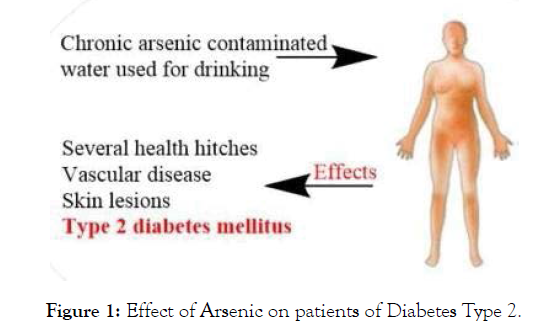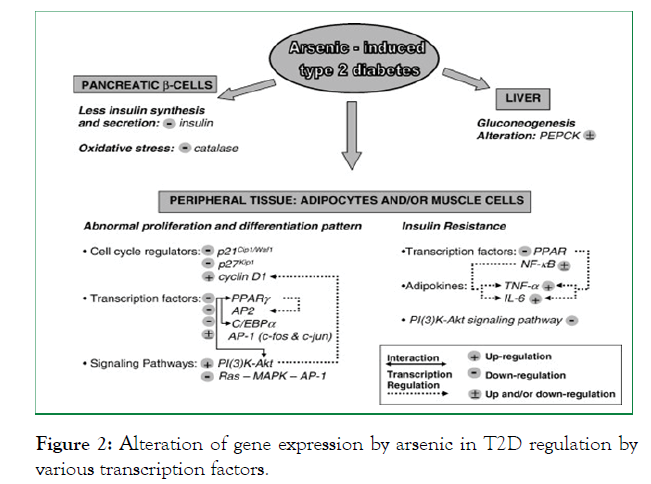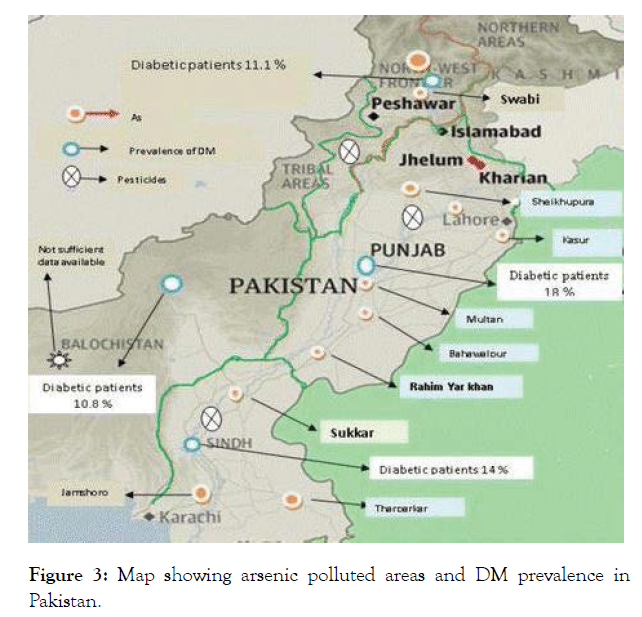Research Article - (2021) Volume 12, Issue 9
Millions of people die each year due to diabetes, it occurs in all groups of ages but there is no proper cure of this disease. There are so many causes of diabetes like poor life style, genetic factor, environmental pollutants and heavy metals etc. Heavy metals exposure is widespread and type 2 diabetes is reaching epidemic extent. Genetic variations can be considered as internal contributing factors in susceptibility of individuals to heavy metals and metalloids like cadmium, arsenic and related other toxicities. Polymorphism in different genes, which are directly/indirectly involving in the metabolism of arsenic, cadmium and other biological pollutants, may lead to accumulation of these pollutants in the body. It may lead to metabolic disorders such as type 2 diabetes. This study is designed to determine the effect of heavy metals as arsenic exposure as diabetogenic agents on the patients suffering from type 2 diabetes mellitus and it’s genetic and proteomic analysis against heavy metals. For this purpose, blood samples of diabetes patients will be collected from different areas of Pakistan. All base line hematology, physical, biochemical parameters from blood samples will be assessed by electrophoretic, chromatographic and mass spectrometric analysis. Genomic, Proteomic, Atomic Absorption analysis will be carried out by using advanced molecular biology techniques. In the present work, main focus on some of the most important heavy metals like arsenic exposure, their properties and effects that is documented and suspected risks on the human population. In this work, the main purpose is to determine the effect of arsenic exposure on type 2 diabetes mellitus, the expression of genes and proteins on human blood and help in early diagnosis, preventive and management of the disease.
Diabetes; Arsenic; Kasur; Pollutant
Diabetes Mellitus is one of the most widely and deadly ailment in current era. In Pakistan 4th most prevalent disorder and every 4 persons is diabetic [1]. Diabetes mellitus is a chronic inflammatory disease characterized by multiple macro vascular and micro vascular abnormities which can affect our body's response to pathogens. The prevalence of DM is rising due to increased obesity and population ageing. Insulin resistance, a hallmark of Type 2 diabetes, is a pathological condition, in which cells fail to respond to insulin [2]. The incidence of Type 2 diabetes has increased globally and along with well-known factors the role of environmental factors and heavy metals on development of diabetes has gained considerable attention. The random release of toxic biological pollutants by various industrial activities into the surrounding environment has inflicted major damage to all the living organisms of biosphere [3].
Variable loads of adverse environmental exposures, congenitally reduced pancreatic beta-cell mass and Host genetic susceptibility are the factors which increased the individual risk of diabetes. A meta-analysis of many prospective cohort studies showed that patients with diabetes have a higher risk of death from all causes compared with patients without diabetes [4].
Risk factors of diabetes
Diabetes is certainly not a typical etiological issue and is accepted to be brought about by different elements like hereditary transformation, physiology, monetary and wellbeing propensities [5,6] Main driving variables of overall diabetes episode involve overweight and weight, stationary way of life, and upgraded intake of unfortunate eating regimens with raised groupings of red meat and prepared meat, refined grains, and improved drinks [7].
Epidemiology of diabetes
Above the earlier three centuries, the percentage of persons having diabetes mellitus has enlarged by fourfold, and diabetes mellitus is the fourth principal cause of death. Collectively about 1 in 4 adult individuals now have Diabetes mellitus, out of which 90 percent have Type 2 Diabetes mellitus. Asian states are a main zone of the fast-growing global epidemics of diabetes. According to IDF 2019, frequency of diabetes was estimated around 9.3 percent that is 463 million individuals in 2019 internationally, increased around 10.2 % (578 million) by 2030 and 10.9% (700 million) by 2045. In city areas the occurrence (10.8 %) which is greater than in rural areas (7.2 %) as well as in high income (10.4%) with comparison to less developed countries (4.0%). Around 50% people having diabetes are uninformed about it. The frequency of diabetes in 2017 in individuals had ages between 18 to 99 years noticed at 8.4 % and estimated to be rise at 9.9 % in 2045. It was informed in a paper that there were 451 million people had diabetes nationally in 2017 (age of 18 to 99 years) and these statistical facts would increase about 693 millions till 2045.
WHO has predicted that in 2025, there would be minimum 300 million people living with diabetes worldwide, it would almost double the frequency of about 2000 [8-11]. Almost 200 million women are living with diabetes, expected to increase to 313 million in 2045.The degree of Type 2 diabetes is greater in town regions in comparison to village areas where the persons are spending a physically active life. The frequency of Type 2 Diabetes mellitus in city and village areas of Pakistan is 14.81% and 10.34% respectively. The occurrence of Type 2 Diabetes mellitus in Pakistan is 11.77%. So, the frequency is greater in men than women and more existing in cities than village areas [12].
Heavy metals act as diabetogenic agents
Heavy metals as ubiquitous elements in environment could be the origin of various difficulties in human body. The amounts of heavy metals in human body are found to be associated with sex, age, diet, life style, occupation and exposure level. Diabetes mellitus (DM) is considered one of the leading health issues that are egregiously threatening human life throughout the world. There are too many chemicals present in the environment that are linked with diabetes. There are many chemicals and heavy metals like arsenic, zinc, cadmium etc. That effect sensitivity of insulin and affect beta cells then to trigger Type 2 diabetes. Arsenic copmounds are classified as endocrine disrupters and cause disruption and interference activities with estrogen receptors and act as a diabetogenic agent [4].
Arsenic a metalloid and heavy metal that can be toxic to humans and other organisms, is present naturally and anthropogenically throughout the world at varying concentrations, including concentrations of concern in soil or groundwater. People are exposing to arsenic through air, food and water. Due to consumption of arsenic contaminated air, water and arsenic rich food, level of arsenic in the human bodies is increasing and making them arsenic toxic. People who are poisonous with arsenic have more vulnerability for diabetes [13]. Arsenic comes in four common valence states: As (organic), As (III), As (V) and Arsine gas and three common forms: inorganic salt, organic salt, and gaseous form (Figure 1).

Figure 1: Effect of Arsenic on patients of Diabetes Type 2.
Linkage of diabetes mellitus with diabetogenic agents
Because of wide spreading problem of diabetes and abundant presence of chemicals in the environment, present study has been selected. Arsenic and cadmium are commonly present in the environment naturally and it is also releasing into environment due to anthropogenic reasons. People are exposing to arsenic through air, food and water. Due to consumption of arsenic contaminated air, water and arsenic rich food, level of arsenic in the human bodies is increasing and making them arsenic toxic. People who are poisonous with arsenic have more vulnerability for diabetes. So, it is important to know about the environmental pollutant and its effects on diabetes to cure it and reduce its number [7]. Rana et al. [14] worked in genetic association of IDE, POU2F1, PON1, IL1α and IL1β with type 2 diabetes in Pakistani population. Riaz et al. [7], in 2020 studied and found as emerging links between heavy metals exposure and insulin resistance: Human, animal, and cell study data. Shokat et al. [15,16], in 2007 and 2008 in studied fluoride toxicity on the histopathological aspects of liver and kidney in the fish fauna Cirrhinus mrigala and reported highly expressed fluoride and its significant changes (Figure 2).

Figure 2: Alteration of gene expression by arsenic in T2D regulation by various transcription factors.
The following review is undertaken to address the possible role of arsenic and pesticides in the prevalence of diabetes in Pakistan and to highlight a resourceful targeted research in this area (Figure 3).

Figure 3: Map showing arsenic polluted areas and DM prevalence in Pakistan.
Rehman et al. [17] studied the Transcriptome responses in blood reveal distinct biological pathways associated with arsenic exposure through drinking water in rural settings of Punjab, Pakistan. In addition, upon implementing the integrative SNPs-based genetic risk factor, pathways associated with an increased risk of NAFLD and diabetes appeared significantly enhanced by down-regulation of genes NDUFV3, IKBKB, IL6R, ADIPOR1, PPARA, OGT and FOXO1. According to WHO 2020 [1], the current recommended limit of arsenic in drinking-water is 10μg/L and above it will be toxic. Recommended levels in water are less than 10-50μg/L (10-50 parts per billion). The lethal dose of arsenic in acute poisoning ranges from 100 mg to 300 mg. The Risk Assessment Information System database states¬ -the acute lethal dose of inorganic arsenic to humans has been estimated to be about 0.6mg/kg/day. Most cases of poisoning are accidental. Arsenic acts by changing the functioning of around 200 enzymes. Diagnosis is by testing the urine, blood, or hair. Arsenic is related to heart disease (hypertension-related cardiovascular disease), cancer, stroke (cerebrovascular diseases), chronic lower respiratory diseases, and diabetes. Skin effects can include skin cancer in the long term, but often prior to skin cancer are different skin lesions. The World Health Organization (WHO) Guidelines for drinking water quality established in 1993 a provisional guideline value of 0.01 mg/L (10 parts per billion) for maximum contaminant levels of arsenic in drinking water. This recommendation was established based on the limit of detection for most laboratories' testing equipment at the time of publication of the WHO water quality guidelines. More recent findings show that consumption of water with levels as low as 0.00017 mg/L (0.17 parts per billion) over long periods of time can lead to arsenicosis [12].
People are exposed to elevated levels of inorganic arsenic through drinking contaminated water, using contaminated water in food preparation and irrigation of food crops, industrial processes, eating contaminated food and smoking tobacco. Long-term exposure to inorganic arsenic, mainly through drinking-water and food, can lead to chronic arsenic poisoning. Skin lesions and skin cancer are the most characteristic effects (Table 1).
| Genes | SNPs | Function | References |
|---|---|---|---|
| AS3MT (Arsenic gene) | rs1119143 9 | The key enzyme in the pathway for the methylation of iAs | Drobna et al., 2012 |
| GST (Arseni c gene) | rs1695 | The glutathione S- transferase (GST) family comprises several classes of GST isozymes, the polymorphic variants of GSTM1, T1 and P1 genes result in decreased or loss of enzyme activity. | González-Martínez et al., 2020 |
| rs156697 | |||
| NOTC H2 (Arsenic gene) | rs699780 | Glucose,galactose, fructose, mannose,glucosamine | Pan et al., 2013 |
| MT2A | rs28366003 | Associated with the risk of Type 2 diabetes | Hattori et al., 2016 |
Table 1: The following genes and gene variants are involved in heavy metals toxicity.
The following genes and gene variants are involved in heavy metals toxicity:
Millions of people die of diabetes and different types of other related complications every year. BMI, when increased, disrupts the body function and can lead to Diabetes Mellitus, which is a risk factor for many diseases. So, it should be maintained to a normal range both in patients suffering from Diabetes Mellitus and normal healthy control. An increase in blood sugar level results in the disturbance of the metabolic system of the body. By taking these preventive measures, diabetes and different types of complications can be controlled and can be less dangerous. This research is done to develop awareness among individuals having diabetes from the risk factors contributing it and to find out preventive measures of these diseases. The findings from present research work will assist in planning preventive and effective treatment strategies for diabetic by identification and characterization of genes, proteins and role of heavy metals like arsenic and cadmium as diabetogenic pollutants by using advanced molecular techniques and methods [17-25].
These investigations shall be helpful in assessing the biochemical, demographic gene, protein alterations in the target group and effect of heavy metals which should contribute in the development of treatment plans for this one of the most widely occurring and debilitating disease in world population. The other financial gains accruing from this project is the application of the project results in developing therapy methods locally for routine use in our clinical laboratories. It also helps in producing PhD thesis and Publications at international level. Results from this research will also contribute for the diagnostic procedures that were unique for early control of the complications coming in our diabetes population [26-30].
These findings will provide a platform for the treatment of diabetic patients suffering affecting from heavy metals. The research work proposed to be undertaken under this project shall elucidate the roles of heavy metals in diabetes mellitus in our population. It should also enable us to understand the levels of expression of the different blood genes and proteins. The other financial gains accruing from this project is the application of the project results in developing diagnostic genomic and proteomic methods locally for routine use in our clinical laboratories [31-35]. The goals of the project are not only to diagnose effective and preventive measures for diabetes but also to create new knowledge and develop processes for application to meet our needs.
Citation: Riaz S (2021) Molecular Level Evaluation of Arsenic as Diabetogenic Agent in the Diabetes Mellitus. J Diabetes Metab. 12:895.
Received: 03-Feb-2021 Published: 23-Sep-2021, DOI: 10.35248/2155-6156.21.12.896
Copyright: © 2021 Riaz S. This is an open access article distributed under the terms of the Creative Commons Attribution License, which permits unrestricted use, distribution, and reproduction in any medium, provided the original work is properly cited.